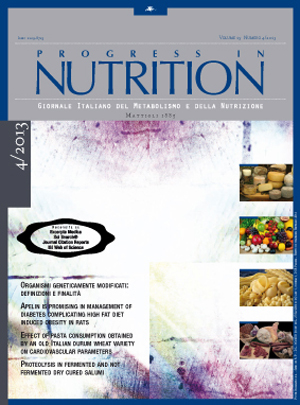Mare milk fatty acids with reference to donkey, cow, goat and human milk
Keywords:
Mare milk, fatty acids, linoleic acid, α-linolenic acidAbstract
Trials were carried out on 6 Noriker (N),12 Thoroughbred (TH), 38 Haflinger (H) and 9 Amiata donkeys milk samples collected at 30, 60 and 90 days from delivery. FA profile was investigated referring mainly to linoleic acid (LA), α-linolenic acid (ALA), LA/ALA ratio and saturated/unsaturated ratio. LA content was higher in Thoroughbred milk samples at 30, 60 and 90 days. LA/ALA ratio was 0.51, 0.49, 0.39 in Noriker samples at 30, 60, 90 days with a saturated/unsaturated ratio about 1. In Thoroughbred milk samples saturated/unsaturated ratio was 0.87, 0.71, 0.57 and in Haflinger samples 1.24, 1.09, 1.29 respectively at 30, 60, 90 days after delivery. Investigations concerned also milk FA content from Haflinger, Noriker ,Thoroughbred and Amiata milk samples collected at 60 lactation days compared with cow, goat and human milk collected at the same time. Unsaturated FA were found about 55% in mare samples, higher than cow and goat (33.49%-30.21%) and similar to human milk (54.62%). Lower levels (25.13%) were found in Amiata samples. All mare samples were rich in LA (6.22%-15.41% FA) and ALA (7.88%-12.50%). In human milk LA and ALA were 13.54% and 1.02%, respectively; LA and ALA content was high also in donkeys samples (8.17% and 6.69%) and lower in goat (2.62% and 0.63%) and in cow (1.86% and 0.57%). Saturated/unsaturated ratio range was between 0.70 and 1.09 in different horses breed samples, 3.04 in Amiata 2.30 ratio was observed in goat samples, 1.88 and 0.83 respectively in cow and in human milk samples.Downloads
Published
Issue
Section
License
This is an Open Access article distributed under the terms of the Creative Commons Attribution License (https://creativecommons.org/licenses/by-nc/4.0) which permits unrestricted use, distribution, and reproduction in any medium, provided the original work is properly cited.
Transfer of Copyright and Permission to Reproduce Parts of Published Papers.
Authors retain the copyright for their published work. No formal permission will be required to reproduce parts (tables or illustrations) of published papers, provided the source is quoted appropriately and reproduction has no commercial intent. Reproductions with commercial intent will require written permission and payment of royalties.

This work is licensed under a Creative Commons Attribution-NonCommercial 4.0 International License.


